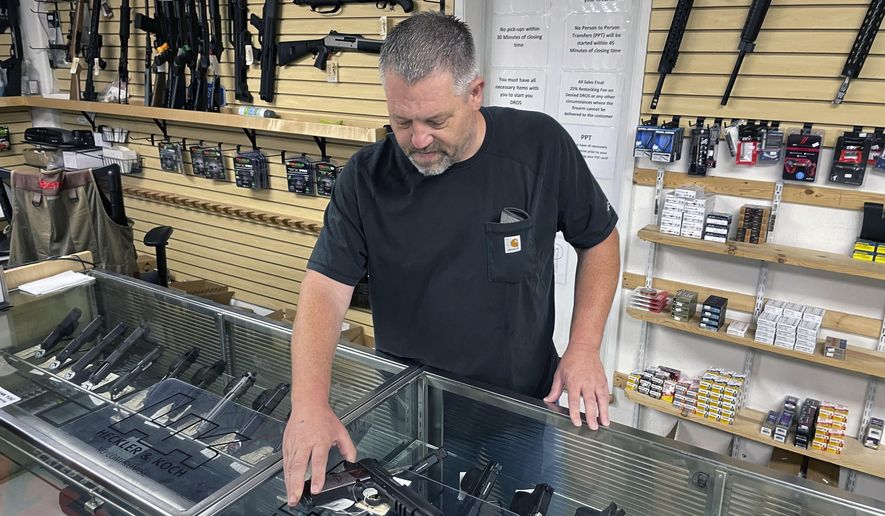Second Amendment activists, armed with the Supreme Court’s ruling on the right to carry firearms for self-defense, are rushing to lower courts to challenge laws including age restrictions on handgun purchases and bans on some types of firearms.
Targets include laws that existed before last month’s ruling in New York State Rifle & Pistol Association v. Bruen and laws that Democratic-led states have rushed to enact in the wake of the 6-3 decision, which shot down New York’s restrictions on issuing concealed-carry permits.
“This is just the beginning of what is likely to be a tsunami of litigation commenced by gun-rights-oriented plaintiffs,” said Mark W. Smith, a Second Amendment expert and a scholar at the Ave Maria School of Law.
“Just as Brown v. Board of Education was a landmark moment in dismantling the Jim Crow regime of ‘separate but equal’ and in the ensuring of equal rights, so too is Bruen a landmark case that will pave the way for a fuller vindication of our civil rights under the Second Amendment,” Mr. Smith said.
It’s easy to see why gun rights supporters are excited.
The court wiped away New York’s law and laws in five other states that put conditions on concealed-weapons permits. Activists expect a rush of gun owners to apply for permits.
SEE ALSO: New California law allows civil litigation against gun manufacturers
Justice Clarence Thomas’ opinion served as a legal lecture, telling judges to start taking the high court’s Second Amendment jurisprudence seriously.
He said the test courts must determine whether a firearm restriction would have seemed reasonable to the founding generation that crafted and ratified the Second Amendment. If not, he wrote, then the law must give way to the Constitution.
Justice Thomas said lower courts invented a two-part test that looked at the history and then balanced it against states’ reasons for enacting buying bans.
“Despite the popularity of this two-step approach, it is one step too many,” he said.
The Second Amendment Foundation has asked a federal judge to use that one-step historical test in a case challenging a federal ban on handgun purchases by people younger than 21. The foundation said it was lawful historically for 18-year-olds to own firearms.
“Text, history and tradition all point uniformly in this case toward 18-to-20-year-olds having equal rights to other adults with respect to firearms, including the right to purchase them, and the Government has not pointed to any sufficiently rooted analogous historical restrictions that would take this case outside the scope of the Second Amendment’s protections,” the group argued in its case, Reese et al. v. BATFE.
The Firearms Policy Coalition is pointing to Bruen in its case filed this week against New York’s ban on assault weapons. Though a lower court upheld the state’s law, the group is arguing that Bruen should change the court’s legal analysis.
“There is no constitutionally relevant difference between a semi-automatic handgun, shotgun, and rifle. While some exterior physical attributes may differ — wood vs. metal stocks and furniture, the number and/or location of grips, having a bare muzzle vs. having muzzle devices, different barrel lengths, etc. — they are, in all relevant respects, the same,” the group argued in its complaint.
“As a matter of law, any regulation that bans firearm ownership in common use for lawful purposes like self-defense is inconsistent with this nation’s history and tradition.”
Democratic-led states are pushing back on the Supreme Court’s ruling.
California Gov. Gavin Newsom this week signed a bill allowing victims of gun violence, as well as state and local government agencies, to bring civil liability lawsuits against firearms manufacturers.
In New York, lawmakers responded to the Supreme Court’s ruling on concealed-carry permits by passing a bill declaring much of the state to be sensitive locations off-limits to weapons. Permit holders would also have to ask permission before carrying firearms onto private property.
Those seeking permits would have to turn over social media account information.
Carl Paladino, a New York state candidate for Congress, has sued to halt the law.
“Apparently, New York Democrats didn’t read the part of Justice Thomas’ opinion where he said: ‘The constitutional right to bear arms in public for self-defense is not a second-class right, subject to an entirely different body of rules than the other Bill of Rights guarantees.’ This new law attempts to treat Second Amendment rights in a way that would be unthinkable in the context of First Amendment rights,” Mr. Paladino said.
Jim Urso, deputy director of communications for New York Gov. Kathy Hochul, said the new legislation complies with the high court’s standard.
“Governor Hochul signed landmark legislation developed to comply with the Supreme Court’s recent decision in NYSRPA v. Bruen and drafted in close collaboration with the legislature. We have no further comment given pending litigation,” he said.
But Mr. Paladino vows he’s willing to fight all the way to the Supreme Court.
Legal experts said it could be some time before the justices take on such a high-profile Second Amendment challenge again.
Before last month’s ruling, it had been more than a decade since the justices handed down decisions in the Heller and McDonald cases, which established a personal right to bear arms.
“Generally speaking, the court’s view is that it leaves even important legal questions by and large to lower courts to decide in the first instance,” said Eugene Volokh, a professor at UCLA School of Law. “It takes a while for a new case to go up.”
• Stephen Dinan contributed to this report.
• Alex Swoyer can be reached at aswoyer@washingtontimes.com.




Please read our comment policy before commenting.